Private issues (mining companies)
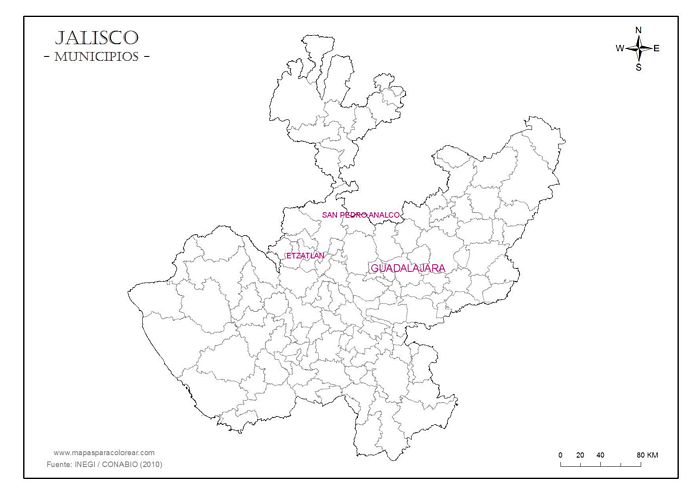
Etzatlán
La Proveedora, S. A.
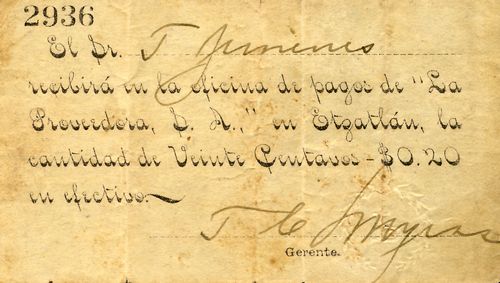
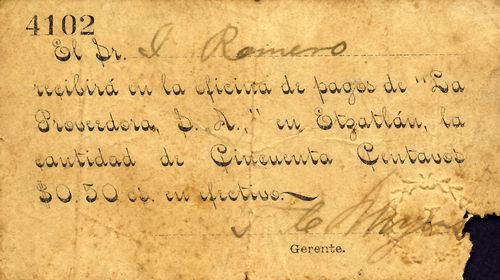
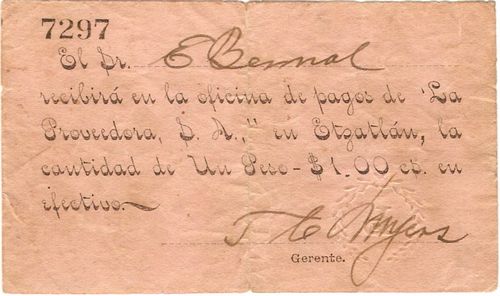
| from | to | total number |
total value |
||
| 20c | includes number 2936 | ||||
| 50c | includes number 4102 | ||||
| $1 | includes number 7297 |
These are chits made out by this mining company to individual workers and payable, supposedly in cash (en efectivo), in the wages office, so not actually paper money. They are signed by the manager, Thomas C. Myers.
|
Thomas C. Myers was an employee of the Ferrocarril Central, working as a conductor on the Guadalajara sectionThe Mexican Herald, 15 June 1904. In 1902 he acquired the Culebra mine, one mile south of Etzatlán, an old Spanish mine that had been abandoned in 1843, and organised the Myers Mine and Milling Company, with some other railway employees from San Luis PotosíThe Mexican Herald, 12 October 1907. Myers became the general manager. In January 1904 Myers sold an interest in his mine to a H. K. Myers, a mining engineer of PhiladephiaThe Mexican Herald, 29 January 1904. The mine struck bonanza ore in 1904The Mexican Herald, 15 June 1904 and the next year Myers bought out H. K. Myers The Mexican Herald, 26 July 1905. |
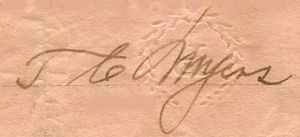 |
Amparo Mining Company
On 6 May 1914 it was reported that this mine had suspended operations. More than two thousand workers had been laid off by the Amparo Mining Company, who had been receiving a daily allowance(?) in vales of 50c (quienes han estado recibiendo en vales de 50 centavos un diario), while they stayed and looked for other workEl País, Año X, No. 4608, 6 May 1914.
By 1916 the company was managed by an Englishman, Santiago H. Howard. When the company closed its tienda de raya it established a shop at which it sold clothes and everything else its workers needed, including basics, at 1913 pricesBoletín Militar, Tomo III, Núm. 277, 26 September 1915.
The notes of the Amparo Mining Company, Etzatlán, were payable in carne (meat). One series was modelo 5322, produced in January 1916.
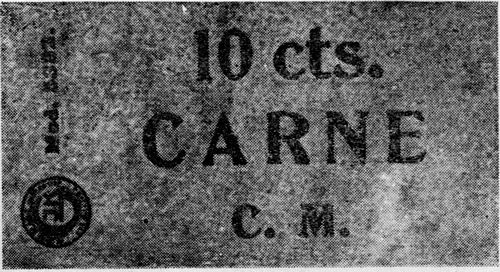
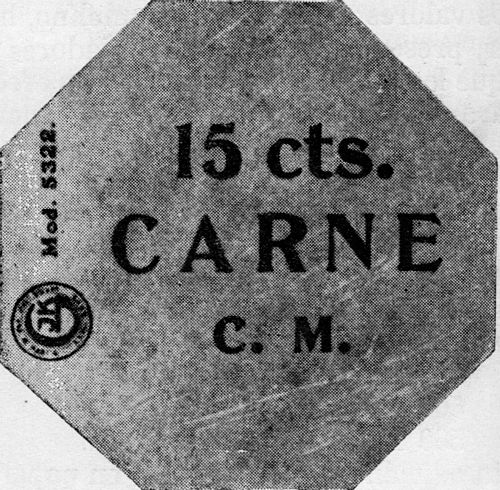
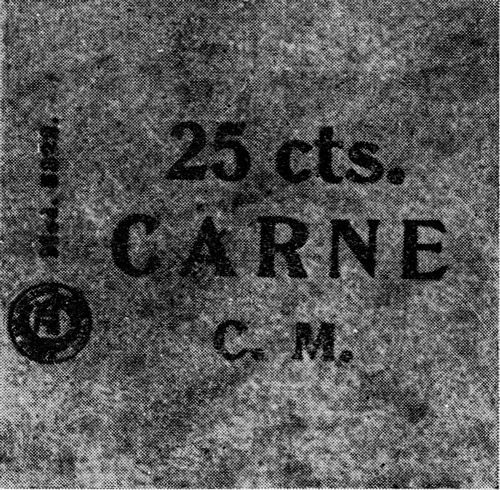
| total number |
total value |
Comment | |
| 10c | 500 | $ 50.00 | oblong brown cartón |
| 15c | 500 | 75.00 | octagonal brown cartón |
| 25c | 500 | 125,00 | square brown cartón |
| 1,500 | $250.00 |
Another series was modelo 5343, ordered on 11 April 1916, and denominated in kilos (of meat).
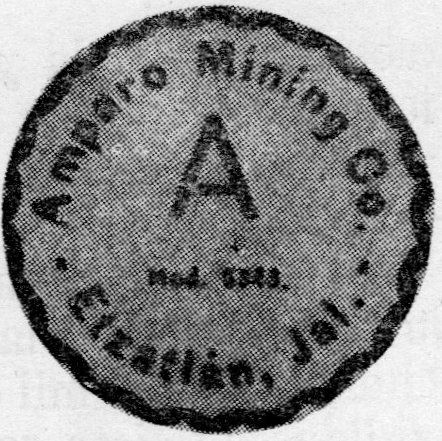
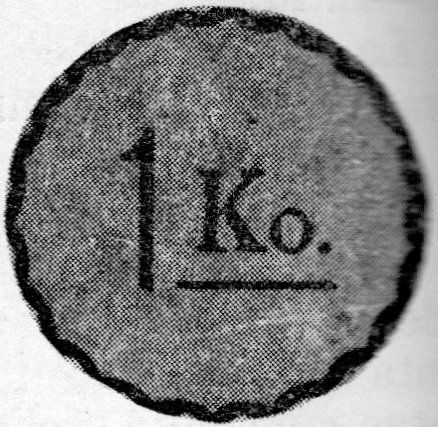
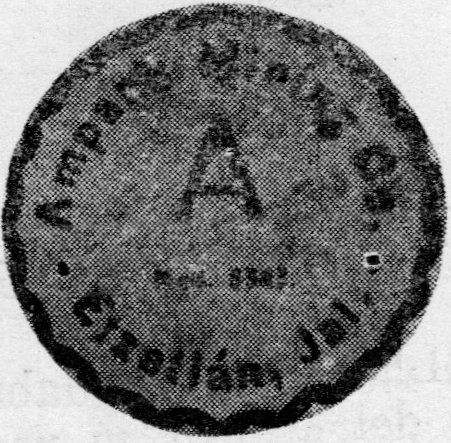
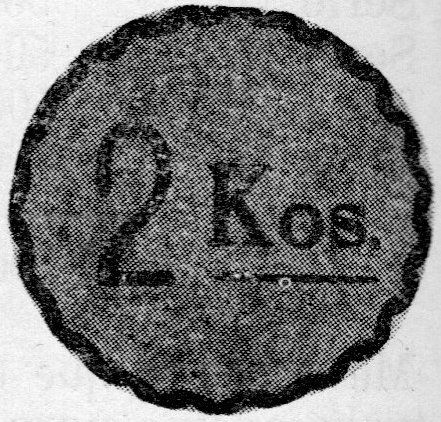
| series | total number |
total value |
Comment | |
| 1 kilo | A | 500 | round brown cartón | |
| B | 500 | |||
| C | 500 | |||
| D | 500 | |||
| E | 500 | |||
| F | 500 | |||
| G | 500 | |||
| 2 kilos | A | 250 | round brown cartón | |
| B | 250 | |||
| C | 250 | |||
| D | 250 | |||
| E | 250 | |||
| F | 250 | |||
| G | 250 | |||
| 5,250 |
Mexican Paper Money also lists certain items as "fractional currency notes, used to pay employees". However, as these are non-negotiable chits they are not really paper money.

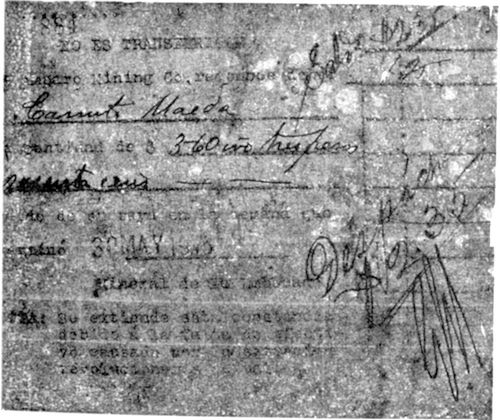
Nueva Compañía Minera de “La Mazata y Anexas,” S. A.
The Mazata gold and silver mines were located seven kilometres north of Etzatlán on land owned by the Estancia de Ayllones. In March 1913 the President of the Compañía Refaccionaria de “La Mazata” S. A. was Carlos Romero and the manager Juan N. SotoAHME, Sección Gobierno/Directoria, Serie Informes, Año 1913, exp. 153, f11.
By 1915 or 1916 it was the Nueva Compañía Minera de “La Mazata y Anexas,” S. A. and as such, issued comprobantes de trabajo which were exchangeable at the company’s offices for infalsificables or a cheque.
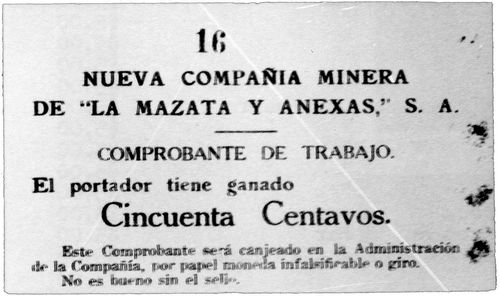
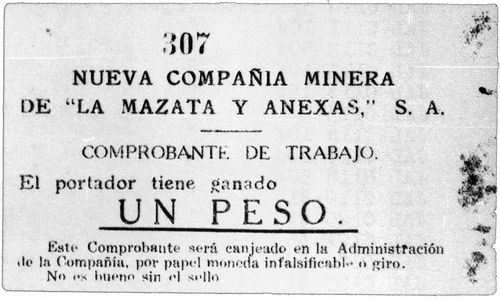
| from | to | total number |
total value |
||
| 50c | includes number 16 | ||||
| $1 | includes number 307 |
This was obviously a response to the lack of low value notes or coins.
In December 1923 several citizens of Etzatlán complained to the Secretaría de Industria, Comercio y Trabajo, that the Negociación Minera “La Mazata” and the owners of the nearby Estancia de Ayllones did not allow free commerce because they had replaced metallic coinage with boletas of various valuesAHME, Sección Gobierno, Serie Petitiones/Solicitudes, Año 1922, exp. 825, f5. On 30 December the Presidente Municipal of Etzatlán, Ramón Blanco, wrote to M. Aleala, the manager of the mine, and the owner of the Estancia de Ayllones, to tell them to stop the practice and on 6 January 1923 Aleala responded. Referring just to his mine, he stated that all the operators and employees enjoyed the widest freedom in the purchase of their merchandise, in the place where they like, whether in Etzatlán, the Estancia de Ayllones, or the mine itself and there were no recommendation that they should buy from a certain merchant. All payments were made in oro nacional, and no boletas were usedibid..
San Pedro Analco
Negociación Minera de San Rafael y Anexas
On 23 March 1900 the Compañía Minera San Pedro Analco received permission to take 20,000 litres of water a second from the Santiago river in the municipios of San Pedro Analco and Tequila for use in the mines and smelter that the Negociación Minera San Rafael y Anexas, S. A. possessed at El Rosario.
This company produced a series of 20c, 50c and $1 notes, dated 16 April 1914, for use with local businesses, which carried the notification that they could be exchanged for banknotes in multiples of five pesos. These were produced by the Guadalajara firm of J. M. Iguíniz.
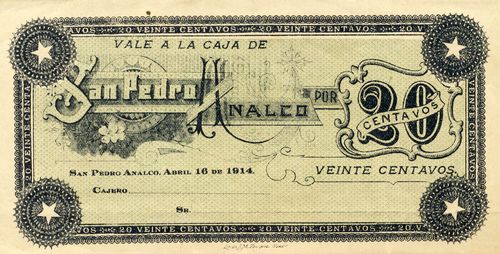
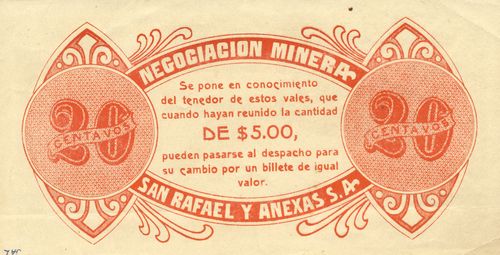
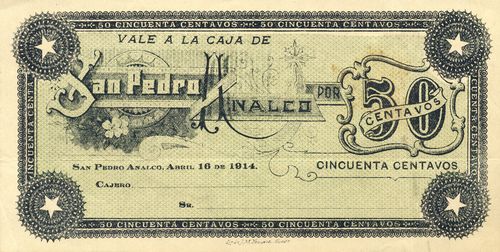
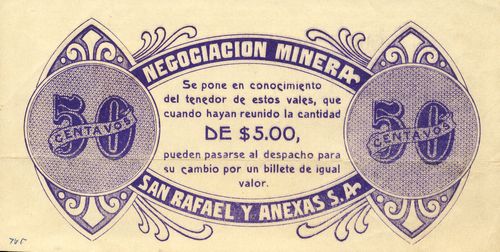
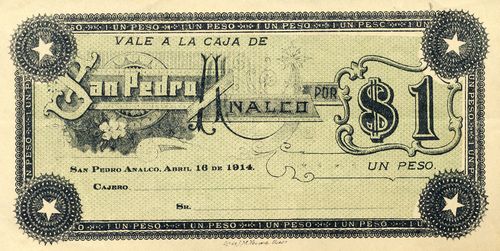
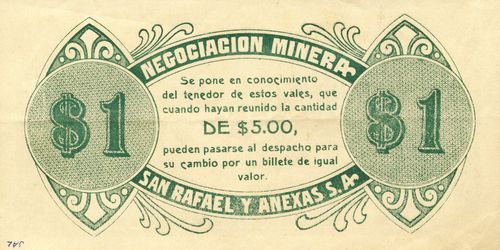
| from | to | total number |
total value |
||
| 20c | |||||
| 50c | |||||
| $1 |
In 1916 Juan Kaiser produced a series of boletos (sheets of coupons) for the company, modelo 5358, ordered on 20 May 1916.
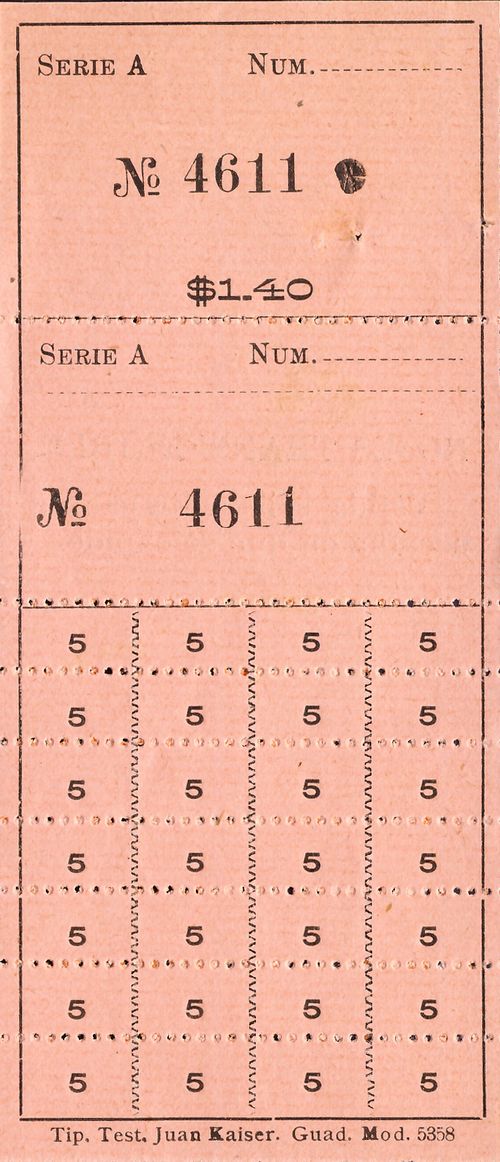
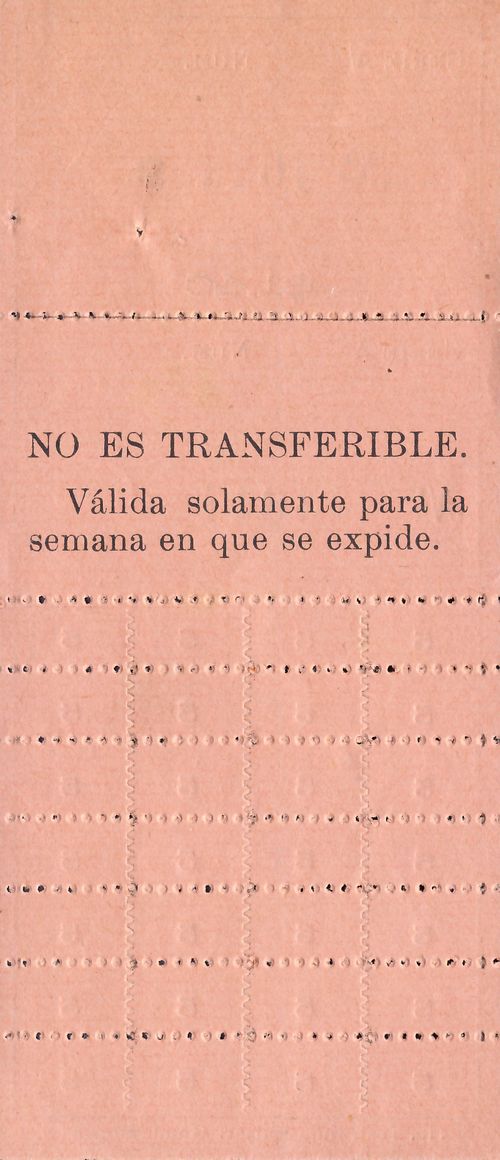
| Series | from | to | total number |
total value |
||
| $1.40 | A | 1 | 7000 | 7,000 | $9,800.00 | pink sheet of 28 x 5c |
| B | 7001 | 14000 | 7,000 | 9,800.00 | orange sheet of 28 x 5c | |
| C | 14001 | 21000 | 7,000 | 9,800.00 | blue-grey sheet of 28 x 5c | |
| D | 21001 | 28000 | 7,000 | 9,800.00 | cream sheet of 28 x 5c | |
| E | 28001 | 35000 | 7,000 | 9,800.00 | sheet of 28 x 5c | |
| 35,000 | $49,000.00 |
and smaller sheets (modelo 5359).
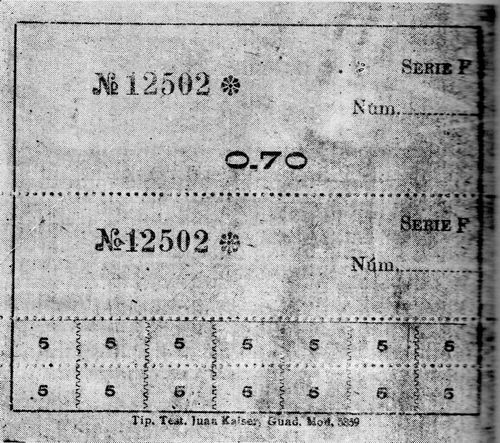
| Series | from | to | total number |
total value |
||
| 70c | F | 1 | 5000 | 5,000 | $ 3,500.00 | sheets of 14 x 5c |
| G | 5001 | 10000 | 5,000 | 3,500.00 | ||
| H | 10001 | 15000 | 5,000 | 3,500.00 | ||
| 15,000 | $10,500.00 |